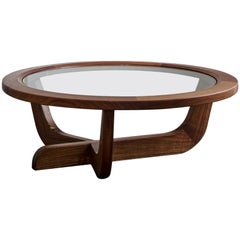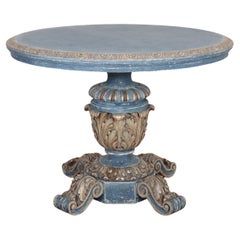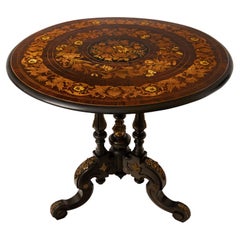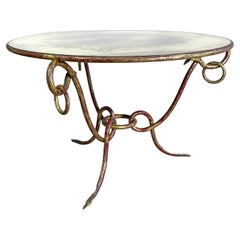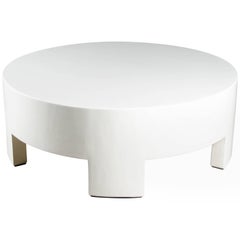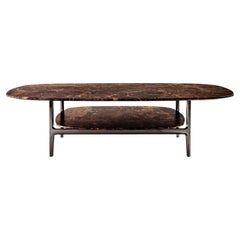Center Tables
2010s Mexican Modern Center Tables
Glass, Walnut
Early 20th Century German Center Tables
Beech
1870s French Louis XV Antique Center Tables
Ormolu
1940s French Brutalist Vintage Center Tables
Iron, Wrought Iron
2010s Center Tables
Lacquer
2010s Italian Mid-Century Modern Center Tables
Marble, Aluminum
21st Century and Contemporary Vietnamese Rustic Center Tables
Wood
20th Century Danish Mid-Century Modern Center Tables
Teak
Early 19th Century English Regency Antique Center Tables
Ebony, Mahogany, Walnut, Satin
Mid-20th Century Danish Scandinavian Modern Center Tables
Hardwood
2010s Unknown Mid-Century Modern Center Tables
Travertine
2010s American Regency Center Tables
Mahogany
20th Century American Mid-Century Modern Center Tables
Marble, Brass
20th Century North American Mid-Century Modern Center Tables
Stainless Steel, Chrome
Mid-19th Century French Empire Antique Center Tables
Marble, Brass
19th Century French Louis XVI Antique Center Tables
Ormolu, Bronze
Mid-20th Century American Georgian Center Tables
Leather, Mahogany
21st Century and Contemporary Italian Modern Center Tables
Resin, Wood
Late 19th Century American Gothic Antique Center Tables
Oak, Walnut
2010s Unknown Mid-Century Modern Center Tables
Travertine
20th Century Spanish Baroque Center Tables
Wrought Iron
Early 1900s French Louis XV Antique Center Tables
Marble
1840s British Early Victorian Antique Center Tables
Mahogany, Walnut
1940s French Neoclassical Vintage Center Tables
Marble, Brass
2010s Italian Modern Center Tables
Stone, Travertine, Marble
2010s Unknown Mid-Century Modern Center Tables
Travertine, Marble
Early 19th Century Austrian Biedermeier Antique Center Tables
Walnut
2010s Turkish Modern Center Tables
Wood, Glass
Early 1900s French Louis XVI Antique Center Tables
Bronze
21st Century and Contemporary Vietnamese Regency Center Tables
Wood
1950s Mexican Mid-Century Modern Vintage Center Tables
Cedar
1920s British Jacobean Vintage Center Tables
Oak
21st Century and Contemporary British Regency Center Tables
Marble
2010s Italian Modern Center Tables
Bronze
20th Century Italian Mid-Century Modern Center Tables
Stainless Steel
1880s British Aesthetic Movement Antique Center Tables
Walnut
2010s Dutch Mid-Century Modern Center Tables
Bamboo, Glass
2010s Unknown Mid-Century Modern Center Tables
Travertine
2010s Unknown Mid-Century Modern Center Tables
Travertine
1930s Slovak Art Deco Vintage Center Tables
Walnut
2010s Unknown Mid-Century Modern Center Tables
Marble
19th Century French Restauration Antique Center Tables
Marble
1980s Italian Post-Modern Vintage Center Tables
Bronze
20th Century French Neoclassical Center Tables
Marble
1980s Italian Mid-Century Modern Vintage Center Tables
Crystal, Marble
1940s Sheraton Vintage Center Tables
Leather, Mahogany
21st Century and Contemporary Portuguese Brutalist Center Tables
Marble
Mid-19th Century English Regency Antique Center Tables
Bronze
1970s American Modern Vintage Center Tables
Chrome
20th Century Minimalist Center Tables
Onyx
19th Century French Antique Center Tables
Marble, Wrought Iron
21st Century and Contemporary Regency Center Tables
Wood, Mahogany
2010s Unknown Mid-Century Modern Center Tables
Travertine
18th Century Italian Renaissance Antique Center Tables
Wood
Early 20th Century Japanese Meiji Center Tables
Wood
1960s Italian Mid-Century Modern Vintage Center Tables
Brass
21st Century and Contemporary American International Style Center Tables
Mahogany, Oak, Walnut
2010s Italian Modern Center Tables
Stone, Marble, Bronze
2010s American Mid-Century Modern Center Tables
Bronze
20th Century American Mid-Century Modern Center Tables
Cane
Antique and Vintage Center Tables
An alluring sitting area doesn’t have to be in the exact center of the room, but an antique or vintage center table is a great tool to partition off such an area.
By definition, a center table is a piece of furniture that is placed in the center of a room. Initially these appeared in the foyer or entryway before making their way into the living room. While one might keep seating furniture such as sofas against the walls to avoid limiting movement and closing off space, a center table in the living room can fill this central space without restricting the flow of the room.
One of the purposes of a center table is to anchor the rest of the furniture. It draws the eye to a specific area and invites guests to sit down. When thinking about how you’ll arrange your furniture, a good rule of thumb is to set tables an arm’s length away from seating. For instance, place a coffee table about 18 inches from a sofa so that it is within reach but not too close. In more modern layouts, tables are sometimes placed to the side to leave a large open area for foot traffic.
Because of its central position, a center table is one of the first things people will notice when entering a room. It’s important to consider how a center table can add to a room, as it’s a crucial element for defining the feel and theme of a room. Some center tables are mainly for decor, while others can be a great place to sit around over cocktails and hors d’oeuvres. Center tables are perfect for displaying decorative objects, floral arrangements, books or a cluster of prized antique vases given the prominent position of your table and the attention it will get.
The clean lines and organic forms that we typically associate with mid-century modern center tables means that they will bring a dose of sophistication to a space, and examples from the era can be found in square and round shapes. Wood tables were popular with furniture makers of the period, but versions in glass and marble are also widely available. Because Art Deco designers frequently incorporated ornamental embellishments such as exotic animal hides and veneers in their seating, case pieces and other furniture, your Art Deco center table will likely make a strong statement in any room. Alternatively, if you’re searching for something small and unassuming, Regency tables could be an option for your space.
Find a growing collection of antique and vintage center tables on 1stDibs today.
